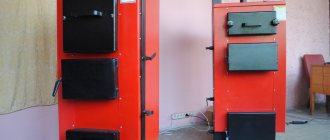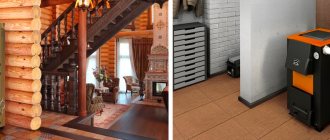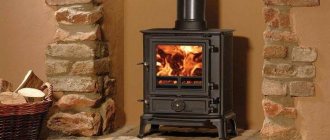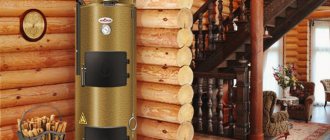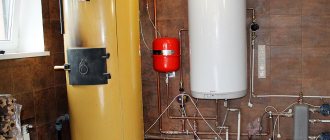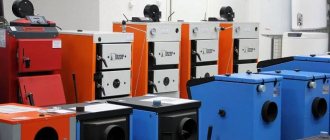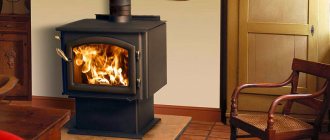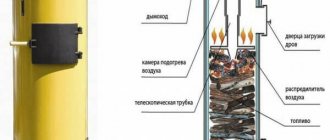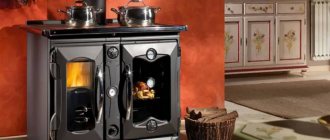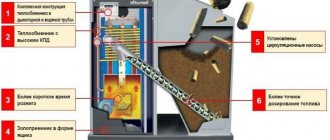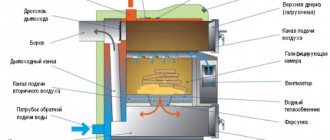The long-burning industrial solid fuel boiler came to our homes not so long ago, although humanity has known about the principle of this kind, slow burning, since medieval times. And the technology of a “smoldering fire” enclosed in a stone vice will be demonstrated in practice by any professional forester or hunter. There are a great many modifications, and almost every seller offers a long-burning solid fuel boiler.
Choosing the optimal and reliable long-burning boiler for a private home can only be done after a thorough assessment of the characteristics of the presented devices. In addition, it will be necessary to coordinate them with the characteristics of the heated room.
A solid knowledge of the range and classification of devices will help you choose a long-burning solid fuel boiler. Let's take a look at their varieties together and see what makes up the price of such an interesting and attractive product.
The demand among the population to buy long-burning solid fuel boilers is based on the constant need to save money, as well as the time spent on adding fuel and regularly cleaning equipment.
Advantages and disadvantages of long-burning boilers
Among heating equipment designed to produce thermal energy used for heating and hot water supply to domestic and industrial facilities, long-burning boilers operating on solid fuel occupy a special place. Such attention to such equipment is associated with the presence of a sufficient number of advantages, in comparison with analogues, when using them, which can be formulated as follows:
- high efficiency of use;
- environmental Safety;
- relatively low cost of fuel used;
- versatility (heating and hot water supply);
- long service life;
- ease of maintenance.
The industry produces units of various types and designs, differing in technical characteristics, types of solid fuel and cost.
Along with this, of course, there are also disadvantages, but they are disproportionately smaller:
- the need to have certain reserves of fuel used;
- labor-intensive maintenance, expressed in periodic cleaning of chimneys and boiler chambers;
- The installation site is subject to strict requirements regulated by fire safety rules and building codes.
What to burn, from sawdust to anthracite
Materials of plant origin are used as fuel for this type of boiler, even peat and coal are essentially plants that existed many thousands or millions of years ago.
Firewood
Firewood is a classic solid fuel; its use dates back as many years as people have been familiar with fire. Firewood from various types of wood is used for boilers; the efficiency of the heating system and its uninterrupted operation largely depend on the type of wood and humidity. As for humidity, it is clear that the lower it is, the higher the heat transfer, since energy is not spent on moisture evaporation, and the properties of various types of wood when used as fuel deserve more careful consideration.
The most suitable option is considered to be deciduous trees, among which the record holders for heat transfer are: oak, beech, hornbeam and ash; birch is not far behind, but if there is insufficient air supply to the combustion site, birch begins to release tar, which is deposited on the walls of the smoke removal system.
Hazel, ash, yew, pear and apple have proven themselves well; they split easily and burn hot, but elm and cherry emit a lot of smoke when burning. Poplar and linden, familiar to city dwellers, are not the most suitable option for a firebox; they burn well, but quickly burn out and spark strongly during the combustion process; aspen and alder are a completely different matter, which not only do not emit soot, but contribute to its burning on the walls of the chimney .
Coniferous trees are characterized by the presence of resins in the composition of the wood, which is ultimately deposited on the inner surface of the pipe; the process of deposition of resin and soot is especially relevant for boilers in which the combustion process occurs at a not very high temperature. The heat transfer of conifers is noticeably lower than that of deciduous trees.
Briquettes
This type of fuel is made from wood chips, shavings, peat, as well as agricultural waste - sunflower husks, straw, etc. Briquettes are produced by pressing, the binder is ligin - a natural mixture of aromatic polymers, no synthetic materials are used in production, so they deservedly considered a clean fuel.
Briquettes are produced in the form of a cylinder or parallelepiped; cylindrical products from some manufacturers have an internal hole along the entire length. Briquettes are not susceptible to fungal attack, have a high calorific value and are very convenient to use, as they have a low ash content of no more than 3%.
Pellets
Pellets are a granular type of fuel that greatly facilitates the task of automating solid fuel heating devices. The material for production is waste from woodworking and agricultural production - sawdust, bark, wood chips, shavings, flax waste, sunflower husks, etc. The material is processed into flour and pressed into cylinders under high pressure, the diameter of the pellets is 5–8 mm, and the length is not exceeds 40 mm. As in the case of briquettes, the binding material is a natural component – ligin.
Types of long-burning solid fuel boilers for heating
Long-burning solid fuel heating boilers used for home heating come in two types:
- Shaft or top combustion boiler . In such devices, fuel combustion occurs in its upper layers, and the heat exchanger is the entire boiler body. Air is supplied to the stacked firewood (coal) through a special telescopic tube from top to bottom, after which, moving in the opposite direction, it promotes the combustion process.
- Top combustion (mine) boilers are universal in terms of the types of solid fuel used (coal, firewood and processed waste from wood processing industries)
- Pyrolysis boilers (gas generators) . Combustion in such units occurs from top to bottom, and the process itself is carried out with limited access to oxygen, resulting in the formation of ash and pyrolysis gas, which, in turn, is burned in the combustion chamber.
Build process
The process of creating a boiler includes several stages. When manufacturing each element, it is worth taking into account the special operating conditions of the product being manufactured.
We cut a section from a thick-walled pipe with a diameter of 100 mm, the length of which will be equal to the height of the firebox. We weld a bolt to the bottom. From a steel sheet we cut out a circle with the same diameter as the pipe or larger. We drill a hole in the circle large enough to pass the bolt welded to the pipe. We connect the circle and the air duct pipe by tightening the nut onto the bolt.
As a result, we will get an air supply pipe, the lower part of which can be closed by a freely moving metal circle. During operation, this will allow you to regulate the intensity of firewood combustion and, consequently, the temperature in the room.
Using a grinder and a metal disc, we make vertical slits approximately 10 mm thick in the pipe. Through them, air will flow into the combustion chamber.
Housing (firebox)
The body will require a cylinder with a sealed bottom with a diameter of 400 mm and a length of 1000 mm. The dimensions may be different, depending on the available free space, but sufficient for laying firewood. You can use a ready-made barrel or weld the bottom to a thick-walled steel cylinder.
Sometimes heating boilers are made from gas cylinders for a longer service life.
Chimney
In the upper part of the body we form a hole for the removal of gases. Its diameter must be at least 100 mm. We weld a pipe to the hole through which the exhaust gases will be removed.
The length of the pipe is selected depending on design considerations.
Connecting the housing and the air supply device
We cut a hole in the bottom of the housing with a diameter equal to the diameter of the air supply pipe. We insert the pipe inside the body so that the air vent extends beyond the bottom.
We cut out a circle from a metal sheet 10 mm thick, the size of which is slightly smaller than the diameter of the body. We weld a handle made of reinforcement or steel wire to it.
This will greatly simplify the subsequent operation of the boiler.
Convection hood
We make a cylinder from sheet steel or cut a piece of pipe, the diameter of which is several centimeters larger than the outer diameter of the firebox (body). You can use a pipe with a diameter of 500 mm. We connect the convection casing and firebox together.
This can be done using metal jumpers welded to the inner surface of the casing and the outer surface of the firebox, if the gap is large enough. With a smaller gap, you can weld the casing to the firebox around the entire perimeter.
From a steel sheet we cut out a circle with the same diameter as the firebox or a little larger. We weld the handles to it using electrodes, wire or other available means.
Considering that the handles can become very hot during operation of the boiler, it is worth providing special protection made of material with low thermal conductivity.
Legs
To ensure long burning, we weld the legs to the bottom. Their height should be sufficient to raise the wood-burning boiler at least 25 cm above the floor level. To do this, you can use various rolled products (channels, angles).
Congratulations, you have made your own wood-burning boiler. You can start heating your home. To do this, just load the wood and light it by opening the lid and heat dissipation disk.
Despite the fact that science and technology have come far ahead, there is no denying that even today the use of devices such as wood boilers for heating a home is common.
Most models of modern wood-burning boilers today combine the following two elements: a traditional source of thermal energy - wood, as well as a steam heating system, which came into use relatively recently - 100-150 years ago.
For those who live in the city, such a persecution of ancient traditions in the form of wood-burning boilers may seem strange. However, this cannot be said about villages and villages. After all, there is no passing gas main here, electricity fluctuates, and paying bills will be expensive. It is in this case that wood boilers for heating a house will become the only salvation for people in the cold season.
Device, principle of operation and technical characteristics
Different types of long-burning boilers differ in their design, operating principle, and also have their own advantages and disadvantages, as a result of which they should be considered separately from each other.
Long burning mine boiler
The design of a top combustion boiler is shown in the following figure, which shows that the main elements of such units are:
- the housing on which the operating control elements are mounted (air supply regulator, fuel loading doors and ash pan, chimney);
- air heating and fuel combustion chambers;
- supply tube and air distributor;
- pipes for connecting to the heating system.
Design and appearance of a shaft-type unit
A mine boiler can be designed as an independent heat source or be an element of a heating system, as shown in the above figure. In this case, a boiler of this design is called a single-circuit boiler with a water circuit. The operation of a heating boiler of this type is carried out as follows:
- after loading the fuel and igniting it, the air supply regulator is open, it ensures its flow into the upper layer of the stored fuel through a movable distributor;
- as the fuel burns out, the distributor moves down, thereby providing air to its lower layers;
- the fuel burns evenly layer by layer, releasing flammable wood gas;
- the gas enters the second chamber (afterburning chamber), where it ignites and, when burned, releases a large amount of thermal energy;
- A water circuit is mounted in the boiler body, through which the heating system coolant circulates, so the entire area of the boiler is its heat exchange element.
The main technical characteristics of such equipment are:
- power, measured in kilowatts (kW);
- heated area (m2);
- the amount of fuel available for placement in the combustion chamber (m3 and kg);
- size of firewood that can be used, (cm) – for boilers burning wood;
- the amount of water in the boiler jacket;
- duration of burning of one bookmark;
- efficiency;
- maximum possible pressure in the heating system;
- geometric dimensions of the boiler as a whole and its individual elements;
- weight.
Long-burning pyrolysis boiler with water circuit
The design of a pyrolysis boiler involves supplying air from above to the stored fuel (wood), which is ensured by its primary supply system. The stored firewood begins to smolder after ignition, which is achieved by the design of the boiler, which provides a limited air supply at this stage of operation.
Design of a solid fuel pyrolysis unit
The wood gas released in this case (pyrolysis effect) enters the second chamber, where it is mixed with secondary air and burned. Due to the fact that the process of fuel pyrolysis takes a long time, the operation of the boiler on one bed is also quite long. Pyrolysis gas, when burned, gives up its heat to the coolant circulating in the heat exchanger of a solid fuel boiler, equipped with a water circuit and connected to the heating system. The main technical characteristics of pyrolysis boilers are:
- type of fuel used;
- material used in manufacturing;
- burning duration on one tab (hours);
- power, kWt);
- heated area (m2);
- number of circuits;
- efficiency;
- fuel consumption (kg/h);
- dimensions of the boiler, firebox and other structural elements;
- weight (kg).
Types of long-burning boilers
In addition to the fact that long-burning boilers differ in their design (type), they may also have differences in such parameters as the presence of an automation system and a different number of water circuits. The presence of two circuits in the boiler design allows it to be used not only for heating, but also as a source of hot water supply. In such models, one internal circuit of the unit is included in the heating system, and the second - in the hot water supply system. An automatic solid fuel boiler is a set of technical means that ensure the operation of a heating device without human intervention in this process. The highest degree of automation is found in boilers that use pellets (fuel granules) as fuel, made from wood processing waste (sawdust, wood chips, etc.).
Model "Viessmann Vitoligno 100-S"
The best pyrolysis boilers
TRAYAN T15 15 kW
Model of a pyrolysis boiler from a Russian manufacturer using solid fuel. Made of high quality steel, the material does not heat up and is easier to clean than cast iron models.
After prolonged use, the paint may peel off.
Options:
- boiler type - solid fuel;
- type - pyrolysis;
- thermal power - 15 kW;
- heated area - 160 m2;
- installation - floor;
- energy independence - yes;
- control - mechanical;
- Efficiency - 85%;
- fuel - firewood, coal;
- weight - 230 kg;
- pressure - 95%;
- price - 44370 rubles.
Advantages:
- low noise level;
- uniform heating of the room;
- heats up quickly;
- reliable assembly;
- quality material;
- good paint job.
Flaws:
- high price;
- heavy weight.
Bourgeois-K MODERN-12 12 kW
Solid fuel boiler of rich bright color, made of high quality steel. A power of 12 kW is enough to heat a room of 120 m2.
Works on wood, coal, peat briquettes.
Suitable for a country house or workshop.
Options:
- type - boiler;
- fuel - firewood, coal, wood briquettes, peat;
- number of circuits - single-circuit;
- power - 12 kW;
- heated area - 120 m2;
- combustion chamber - open;
- Efficiency - 92%;
- control - mechanical;
- installation - floor;
- thermometer, pressure gauge - yes;
- weight - 220 kg;
- dimensions - 400*1070*780 mm;
- cost - 59,900 rubles.
Advantages:
- ability to use a variety of fuels;
- high efficiency;
- presence of a thermometer;
- stylish design;
- adequately warms the room;
Flaws:
- overcharge;
- heavy weight;
- inconvenient ash pit.
Bourgeois-K MODERN-24 24 kW
A solid fuel boiler from Russian manufacturers with a power of 24 kW, which is enough to heat a private country house with an area of 250 m2.
The device is installed on the floor and runs on solid fuel.
Characteristics:
- type - solid fuel boiler;
- number of circuits - single-circuit;
- thermal power - 24 kW№
- heating area - 250 m2;
- installation - floor;
- non-volatile - yes;
- control - mechanics;
- fuel - coal, firewood, pellets, wood briquettes, peat;
- maximum pressure - 4.5 bar;
- thermometer - yes;
- pressure gauge - yes;
- dimensions - 500*1180*800 mm;
- weight - 310 kg;
- cost - 76,050 rubles.
Advantages:
- high power;
- convenient control;
- The ash pan is easy to clean;
- quality materials;
- reliable assembly.
Flaws:
- high price;
- heavy weight;
- bulky.
TRAYAN T20 20 kW
Solid fuel boiler with a capacity of 20 kW for heating private houses, workshops and other premises. It is heated with coal and wood.
Installation is carried out on the floor, on special legs.
Thick steel ensures the durability of the device.
Characteristics:
- device type - solid fuel boiler;
- contours - one;
- maximum power - 20 kW;
- area - 220 sq.m.;
- installation - floor;
- energy independence - yes;
- control - mechanics;
- combustion chamber - open;
- fuel - firewood, coal;
- functions - thermometer, pressure gauge;
- dimensions - 460*980*760 mm;
- weight - 260 kg;
- price - 51990 rubles.
Advantages:
- fast heating;
- long burning of fuel;
- the manufacturer promptly responds to customer questions;
- ease of use;
- durable materials.
Flaws:
- high price;
- heavy weight;
- bulky;
- small firebox.
TRAYAN T10 10 kW
A solid fuel device with a power of 10 kW for heating a room of 90 m2. Suitable for warming up a small studio, country house or workshop.
Characteristics:
- type of device - solid fuel, pyrolysis boiler;
- power - 10 kW;
- number of circuits - single-circuit;
- area - 90 m2;
- installation - floor;
- thermometer - yes;
- non-volatile - yes;
- control - mechanics;
- combustion chamber - open;
- water pressure - 4.5 bar;
- dimensions - 380*860*670 mm;
- weight - 180 kg;
- cost - 38,990 rubles.
Advantages:
- high-quality assembly;
- convenient use;
- easy to clean ash pan;
- reliable materials;
- fast heating.
Flaws:
- heavy weight;
- high price;
- low power.
How to calculate the power of a heating boiler
The power of the boiler determines its performance and at the same time affects the cost of the heating unit; the higher the power, the more expensive the heating boiler. In this regard, in order to avoid unnecessary financial expenses, when choosing a long-burning boiler, you need to calculate the required power of such a device, which can be done in two ways:
- Considering the average specific power per unit of heated area . In this case, the value taken as a basis is 1 kW per 10 m2, with a ceiling height of up to three meters. Dividing the available area of the premises that need to be heated by 10, we obtain the approximate power of the heating boiler. No. 18. A long-burning wood boiler will ensure the autonomy of the heating system of a country house
- Using the volume of the heated room and the degree of its thermal insulation . In this case, the calculation is performed using the formula:
P = S × h × k , where
P – heating boiler power (kW);
S – area of the heated room (m2);
h – height of the heated room (m);
k - a coefficient that takes into account the degree of thermal insulation, is equal to 40 - for well-insulated rooms and 60 - with poor thermal insulation and a large glazing area of building structures.
For more accurate calculations, we suggest using a convenient online calculator.
Useful tips for making a TT boiler
- If you want to make a TT boiler universal in terms of the use of raw materials, then use a pipe made of heat-resistant alloy steel for the combustion chamber.
You can significantly reduce the cost of building a unit if you take a seamless steel pipe of grade 20.
- Before installing the boiler in the place designated for this unit, carry out the first kindling outside, equipping the boiler with a temporary chimney. This way you will be convinced of the reliability of the design and will see whether the case has been assembled correctly.
- If you use a gas cylinder as the main chamber, then keep in mind that such a unit will provide you with combustion for 10-12 hours due to the small amount of fuel supplied. So, the small volume of the propane tank will decrease after cutting off the lid and ash pan. To increase the volume and ensure longer burning time, it is necessary to use two cylinders. Then the volume of the combustion chamber will definitely be enough to heat a large room, and there will be no need to add firewood every 4-5 hours.
- In order for the ash pan door to close tightly, preventing air from entering, it must be well sealed. To do this, lay an asbestos cord around the perimeter of the door.
If you make an additional door in the boiler, which allows you to “reload” fuel without removing the lid, it also needs to be tightly sealed using an asbestos cord.
For the operation of a TT boiler, the diagram of which we attach below, any solid fuel is suitable:
- hard and brown coal;
- anthracite;
- firewood;
- wood pellets;
- briquettes;
- sawdust;
- slates with peat.
There are no specific instructions on the quality of fuel - any will do. But keep in mind that with high fuel moisture, the boiler will not provide a high efficiency.
How to choose a long-burning wood-burning boiler - recommendations from our editors
It is sometimes difficult for an untrained user to choose this or that technical equipment, because... the variety of offers does not allow you to concentrate on the main selection criteria - which ultimately leads to unnecessary financial expenses or the inability of the purchased device to cope with the assigned tasks.
Heating equipment must be installed in specially designed rooms.
Our editorial specialists recommend paying attention to the following points when choosing a wood-burning boiler model:
- Initially, you should determine the required power of the heating device and its scope of use (heating, heating + hot water supply);
- It should be remembered that in the manufacture of such equipment, steel or cast iron is used, and each of the materials used has its own advantages and disadvantages;
- Reliability is guaranteed by the manufacturer, so you need to find user reviews about the model you like, as well as about the company as a whole.
Equipment Variations
All solid fuel units are conventionally divided into homemade and purchased. The former do not have much functionality and are made from improvised materials, and their use requires control, and the efficiency level reaches only 60%.
Homemade option
Industrial options are equipped with various devices that facilitate operation. They can be divided into subgroups:
- with a built-in electric heating element (maximum 2 kW), which allows you not to cool down the equipment during complete combustion of the fuel;
- with rotating air nozzles, which serve to burn associated gases;
- with chamber cooling, that is, an emergency circuit is installed to increase safety;
- with adjustable door pressure, extending service life.
Industrial model
The efficiency of purchased equipment can reach 85%, which significantly saves fuel resources.
Installation and operation rules
In order for the operation of heating equipment to be long-lasting and trouble-free, it is necessary to initially install it correctly and then use it correctly.
Pyrolysis boiler during operation
When installing long-burning boilers, you must:
- Protect building structures from exposure to high temperatures and possible contact of burning fuel parts with their surface.
- The chimney should have the least amount of bends, its height above the roof surface should correspond to its shape.
- The connection between the boiler and chimney must be removable.
Installation and operation rules are described in the accompanying documents for the specific model; however, when using such equipment, you should remember that:
- Firewood must be laid loosely in the firebox to ensure air circulation;
- the amount of incoming air (draft) can be adjusted using a damper and an ash pan;
- Maintenance of long-burning boilers operating on solid fuel consists of removing ash and cleaning the grates, as well as cleaning the chimney.
Models from different manufacturers are very similar in appearance, so when choosing a specific device, you should carefully study the technical characteristics, as well as the requirements for installation and operation
Some recommendations
If you need to create a heating system in a private house or country house, carefully choose the boiler option. You can assemble a model that runs on solid fuel yourself or purchase it in a store.
Wood burning boiler with top loading
This heating method is perfect in the absence of communications to the house, and with the right choice, you can avoid additional fuel loading for up to 7 days.
Homemade long-burning boilers with wood - manufacturing nuances
If you have free time, the ability to work with hand tools, and also the desire, you can make a long-burning wood-burning boiler yourself. When making it yourself, you must remember that:
- The larger the chamber intended for loading fuel, the longer the burning process will be.
- The ash chamber must be closed hermetically, because air enters the working area of the boiler from top to bottom.
- A damper must be provided in the upper chamber to regulate the air supply.
- To ensure long-term operation of the unit being constructed, the metal thickness must be at least 5 mm.
When making a mine boiler yourself, you can use a gas cylinder with a volume of 50 liters
Classic type of unit
This type is used using forced pressurization, which is necessary to avoid smoldering conditions and for economical combustion of solid fuel.
The operating principle is as follows:
- 1. Firewood is placed and set on fire in a firebox with a volume of 112 liters. After this, all the doors are closed tightly, and with the help of automation, the fan is started, pumping air.
- 2. As soon as the temperature reaches the set point, the fan stops and the boiler goes into standby mode. A very small amount of air flows through the channel, closed by a gravity damper, so that the firewood does not go out.
- 3. When the temperature sensor detects that the coolant in the boiler tank has cooled, the fan will automatically turn on and the process will repeat.
With the help of automation, several modes of air injection are carried out in accordance with the wood used, which varies in quality and humidity. The standard type of boiler has the following technical characteristics:
- rated power - 22 kW;
- efficiency - 77%;
- maximum operating pressure - 3 bar;
- firebox depth - 460 mm;
- the size of the opening where the firewood is placed is 36 by 25 cm;
- chamber volume - 112 l;
- Burning time with wood fuel is approximately 8 hours.
The boiler has a simple design: a firebox elongated in height, equipped with grates at the bottom, and at the top - a heat exchanger consisting of 4 pipes and placed inside the tank. The forced air enters the ash chamber through a channel made of a 60 by 40 mm profile. To protect against dirt and dust, the automatic unit and fan are located on top of the boiler.
Long-burning heating boiler using solid fuel
How much does a long-burning boiler cost - price review
The following table shows the average cost of long-burning boilers discussed in this article as of the second quarter of 2022.
| Model | Price, rubles |
| "STROPUVA S 40" | 120 000 |
| "Candle S-18kW" | 88 000 |
| "BuderusLogano G221-40" | 105 000 |
| "Geyser PK-10" | 45 000 |
| "ViessmannVitoligno 100 VL1A025 30 kW" | 245 000 |
| "Bourgeois K TA 20" | 65 000 |
| "BuderusLogano S111 20" | 75 000 |
| "Stropuva S10" | 90 000 |
| "ViadrusHercules U22D-4" | 55 000 |
You can buy an inexpensive long-burning wood-burning boiler from the company that produces it, as well as its dealers, on the Internet, where there are also a large number of offers from organizations involved in the sale of such equipment.
Popular manufacturers and their offers
There are quite a few companies that produce solid fuel boilers, among them there are several of the most popular. Our rating of the best boilers of 2022.
Buderus Logano
A German manufacturer with almost 300 years of experience, his contribution to the development of the production of heating devices can hardly be overestimated. The boilers produced by this company are deservedly considered one of the best on the world market. The company uses only high-quality materials in production, so Buderus Logano boilers are durable and reliable.
Price: 100,000 -109,000 rubles.
| Advantages | Flaws |
| High quality design, manufacturer's warranty up to 20 years | High price |
| Reliable automation | |
| Ease of installation |
Stropuva
This Baltic brand has been known in Russia since 2008, Stropuva units are reliable and have an impressive fuel chamber volume, they can work on one load for up to 5 days, if coal is used, for firewood this limit is limited to 30 hours.
Price: 52,000 - 65,000 rubles.
| Advantages | Flaws |
| High efficiency, minimum 90% | Heavy weight of the unit |
| Economical consumption | Lack of built-in automation |
Protherm
The Czech company Protherm has been present on the Russian market since 2011, during which time the company's products have gained wide popularity due to such qualities as reliability, ease of installation and maintenance, as well as the energy independence of heating devices of this brand.
Price: 52,000 - 60,000 rubles.
| Advantages | Flaws |
| Not expensive | Manual ignition |
| Efficiency up to 90% | Small firebox |
| Built-in automation |
Zota
Who, if not the Siberians, knows what cold is? The Krasnoyarsk enterprise Zota is known for its combined models of boilers. The versatility of the equipment allows you to use different types of fuel - gas, wood, coal or diesel fuel; with such a set of options it is impossible to be left without heat, even in hard-to-reach areas.
Price: 34,000 - 40,000 rubles.
| Advantages | Flaws |
| Built-in automation | Low efficiency, 70% |
| Low price | |
| Built-in electric heater |
Teplodar
A characteristic name for the products of a Russian company, which fully justifies it. Teplodar boilers are distinguished by their versatility; it is always possible to replace wood or coal with pellets or gas; this does not require replacing the unit; it is enough to install the appropriate burner. This brand produces many different models, both expensive and budget.
Price: 30,000 - 90,000 rubles.
| Advantages | Flaws |
| Large selection of models by type and fuel | Additional equipment must be purchased separately |
| Built-in heating element |
Teplodar Kupper
This product from the Teplodar plant allows the owner not to think about problems with purchasing fuel - any will do. The unique design of the Kupper brand is the basis for the efficient operation of the equipment; its efficiency is one of the highest among analogues.
Cooper Pro
Another successful development of the Teplodar company is long-burning boilers Kupper Pro, the entire line of this series has an efficient heat exchanger and a water-cooled grate, the units are equipped with an additional door, there are now three of them on the front side.
Don
Another Russian representative on the market of solid fuel boilers, Don heat generators are produced in Rostov. They have earned their popularity due to their versatility and reliability; the manufacturer uses high-quality boiler steel for production.
Siberia
The NMK plant from Novosibirsk specializes in the production of inexpensive budget models, but despite the reasonable price, Siberia brand units are very efficient, high efficiency is ensured by a grate made of pipes and beams at the flue gas outlet, also filled with coolant.
In conclusion, a few video reviews
Indeed, solid fuel equipment can be installed without worrying about poor infrastructure or distance from large populated areas. You can always choose a model that will provide heat and hot water to residential or industrial premises in the most unfavorable conditions.
Solid fuel boiler. What is the efficiency?
Wood heating? What are boiler sellers silent about?
FAQ
Why does the pressure drop in an electric heating boiler? There may be several reasons for this. First of all, the pressure in the system drops during the first start-up, when air comes out of the pipes filled with coolant - this is a completely normal phenomenon; there are even special air vents for this. This process can take quite a long time, up to two weeks in a system with heated floors. In addition, it is possible that the expansion tank, whose task is precisely to contain pressure drops, is almost filled with coolant. If there is no room for air in the tank, excess pressure in the system will be released through the relief valve. Finally, the most unpleasant and most common reason is a leak in the heating system. In this case, the leak must be identified and repaired so that the pressure stops falling.
Installation of wood chip boilers in a heating system
Making a boiler yourself requires the ability and experience in welding, electrical installation and plumbing work. Knowledge of physics, heat engineering, materials science, and installation rules for heating systems will be useful.
It is necessary to comply with safety techniques and methods. To assemble the boiler you need an equipped room and tools.
Material for the production of a boiler with two chambers:
- sheet steel 6, 5 and 4 mm thick (combustion chamber, heat exchanger jacket and housing);
- corner with shelf sides 50 mm (rigid frame ribs);
Double-circuit TT boiler
with hot water storage tank
- steel pipe (piping of the heat exchanger with the heating system);
- a cast iron grate of suitable size or a round rod with a diameter of 20 mm;
- fireclay brick;
- centrifugal fan;
- ready-made doors with reflector, fastening, handle and lock;
- safety group (temperature sensor, device for determining pressure).
Welded parts are marked with chalk (joint location, part number, dimensions). Special organizations recommend services for cutting material at the place of purchase.
Tools for making a boiler:
- continuous current electric welding machine;
- electrodes (diameter 3–5 mm);
- electric drill;
Heating boiler connection diagram
- angle grinders (for large 230 mm and small 125 mm circles);
- caliper, tape measure, level.
The boiler assembly begins with the inner casing. The quality of the weld seams must ensure the reliability and density of the structure, which is located in direct contact with the thermal fluid.
Solid fuel units – 90% efficiency reality?
Before you get inspired by the idea of creating a solid fuel boiler with your own hands, you should figure out what designs are generally in use today. In general, all existing developments can be divided into 4 groups:
- traditional boilers,
- pyrolysis wood (gas generators),
- long burning,
- pellet boilers.
Traditional designs resemble an ordinary home stove or potbelly stove with the minimum necessary - a window for loading fuel, a combustion chamber, an ash pan and a chimney. The ash pan often serves as a damper, with the help of which the draft is regulated. No automation, electronics, thermometers or other parts for you, which means there is much less chance that something will fail. The main structural element of a solid fuel boiler is the heat exchanger, through which the coolant receives a “charge” of thermal energy. The heat exchanger can be tubular or a water tank made of solid steel sheets.
However, today boilers can also be called traditional, which are distinguished by a more complex system of throttle valves and partitions inside the units - with their help, you can more finely regulate the air draft, as well as increase the path of hot air to the pipe. Thanks to the partitions, the efficiency of the boiler increases - the device transfers more thermal energy to the coolant, and less hot air enters the pipe.
Such boilers are practically omnivorous. Coal, firewood, pellets, or even garbage - as long as it’s dry, as long as it burns. Of course, very simple designs are not economical - their efficiency barely reaches 50%, and often is only 15–20 percent. Such low rates are due to the fact that fuel combustion occurs in a very short period of time, too much thermal energy is released, which simply flies out into the chimney, or the coolant overheats. The same firewood burns out in a matter of minutes, and to maintain heat inside the house you will have to fully load the firebox with firewood at least once an hour. The charcoal burns for 2-4 hours, again releasing too much energy. More modern boilers with throttle valves and partitions do not have this drawback; they are capable of delivering 80% efficiency and burning at full load for up to 8–12 hours, depending on the material, regulating the combustion temperature.
Set of tools and accessories
Welding machine
The main difficulty is to give a thick sheet of heat-resistant steel a cylindrical shape at home. In factories, this operation is performed using mechanical rollers. A manual machine - pipe bender or hand rollers, if desired, can be found in specialized workshops, which will inevitably entail some costs. The rest of the assembly work can be quite successfully completed at home. To do this you will need:
- welding machine;
- angle machine for stripping and cutting metal (grinder);
- tape measure, ruler, caliper, square;
- hammer and chisel;
- electric drill;
- pliers, preferably with long handles;
- other small plumbing tools that are found in every private household.
Traditional or classical combustion principle
- A simple fuel combustion scheme. According to the principle of operation, they resemble an ordinary stove with a special window for supplying fuel.
- The main element is a heat exchanger that ensures temperature transfer directly to the coolant
Such boilers are characterized by unprecedented reliability and durability, but their efficiency leaves much to be desired.
Classic combustion solid fuel boiler with hob
Steel vs cast iron - such different boilers
It doesn’t matter whether you make a solid fuel boiler with your own hands or are going to purchase a ready-made one, you should strive to obtain a unit with optimal characteristics. What specific indicators should a good unit have?
Let's start with which heat exchanger is better - steel or cast iron. You can’t make cast iron at home - you will need not only skills, but also foundry equipment, which you can’t easily buy in a store. Most ready-made models for the home are represented by sectional structures that are separated from each other during transportation and reassembled during installation. During operation, cast iron becomes covered with so-called dry rust, which, as a rule, does not progress and serves as a kind of protective film. Wet corrosion also proceeds much more slowly, which determines the durability of cast iron products - some manufacturers provide a guarantee of 10 years of operation, but in general, such a home heating boiler can last 25 years. The advantage of cast iron heat exchangers is that they are easier to maintain - they need to be cleaned infrequently, since even significant carbon deposits do not reduce the efficiency of the boiler. Repairing a boiler or increasing its power is also very simple - by replacing sections or adding their number. Among the main disadvantages are:
- the heavy weight of the boiler, which is why it even needs a separate foundation,
- high transportation costs and inconvenience during installation,
- fear of thermal shock - do not load cold firewood into the furnace, supply cold water to a hot system, etc.,
- high thermal inertia - they take a long time to heat up, but also take a long time to cool down.
